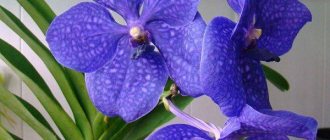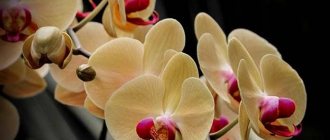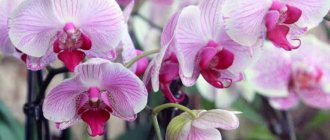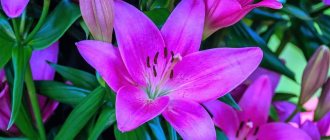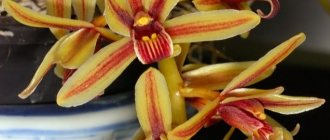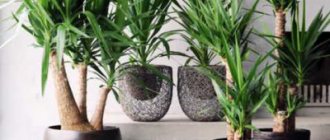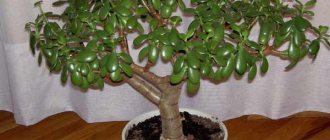One or another person who notices an orchid that is unique in its beauty will undoubtedly stop to admire it, being blinded by the beauty of this flower. There are about 750 types of variations, and approximately 30,000 hybrid models. Moreover, all of them, without exception, have their own characteristics. Plants are known for their grace throughout the world. They are attracted by the hot atmosphere with its significant dampness and temperature changes.
* The rating is based on the number of requests to the Yandex search engine.
Classification of groups of the orchid family
Bletinae
Consists of genera:
- Bletia,
- Calanthe,
- Hysis,
- Fayus.
In home collections there are mainly several terrestrial species of blethylls, calanthus and faius.
Dendrobiums (Dendrobiinae)
Includes childbirth:
- Bulbophyllum,
- Cirrhopetalum,
- Dendrobium.
Dendrobiums are of greatest interest.
Catasetum group (Catasetinae)
Consists of genera:
- Catasetum,
- Clowesia,
- Cycnoches,
- Mormodes,
- Dressleria.
Maxillariidae
Consists of genera:
- Lycaste Lycaste),
- Maxillaria (Maxillaria),
- Zygopetalum.
The most decorative are the lycastes, among which the species stands out: Skinner's lycaste (L. skinneri).
Spiranthinae
The group consists of genera:
- Gemaria,
- Macodes,
- Anectochilus (Anoectochilus),
- Goodyera.
Most of the jewel-leaved species under consideration are rhizomatous terrestrial orchids, with a rosette of rather large, unusually beautiful velvety leaves, of various shades with sparkling silver, golden, and reddish veins.
Coelogyninae
The group consists of genera:
- Coelogyne,
- Pleione,
- Dendrochilum,
- Folidota.
The species of the first two genera are of greatest interest for indoor culture. Orchids with large beautiful flowers, abundant and long flowering.
Cypripedieae
Consists of genera:
- Paphiopedilum and
- Phragmipedium, also known as "Venus' slippers".
Cymbidiums (Cymbididiinae)
The group includes childbirth:
- Anzelia (Ansellia),
- Cymbidium (Cymbidium),
- Grammatophyllum.
Epidendrinae
A group that includes well-known rhizomatous genera with a sympodial type of branching:
- Brassavola,
- Cattleya,
- Epidendrum,
- Lelia,
- Leptotes,
- Sophronitis.
Oncidiums (Oncidiinae)
Which includes remarkable representatives of such genera (based on general characteristics):
- Brassia,
- Cumbria,
- Miltonia,
- Odontoglossum,
- Oncidium,
- Rodriguezia,
- Trichopilia.
Important Details
Varieties of orchids is a very complex question, because it is not so easy to describe all types of orchids. In this article, we talked about the world-famous representatives of this family, described the appearance of orchids and their features in such a way that the reader could find out which specific representative he cultivates in his greenhouse, room or garden.
Important! There is no clear answer to the question of how to determine the type of orchid, since the variety of hybrids, flower shapes and names of orchids is very large and amounts to about 20 thousand.
Each variety of orchids is partly similar to the other, in flowers, leaves, appearance.
Giant Phalaenopsis (Phalaenopsis gigantea)
The largest orchid in the genus Phalaenopsis . This is a spectacular, but difficult species for home culture.
The first giant phalaenopsis was found in 1897 and transported to the botanical garden on the island of Java. It bloomed only after 11 years and soon died. The second specimen, with leaves 90 cm long and 40 cm wide, was discovered in 1937.
Giant phalaenopsis blooms at 6-12 years of age, and in ideal greenhouse conditions at the age of 4-5 years. Produces several long peduncles that bear up to 200 buds.
The natural species readily crosses and many interesting hybrids have been created on its basis . These are plants with wide leathery leaves and hanging peduncles. The flowers are round, fleshy, proportional in shape, with a diameter of 3 to 7 cm. All hybrids are fragrant, with a faint hint of citrus. The petals are lemon-yellow with a greenish tint and red-brown specks in the form of streaks or spots.

